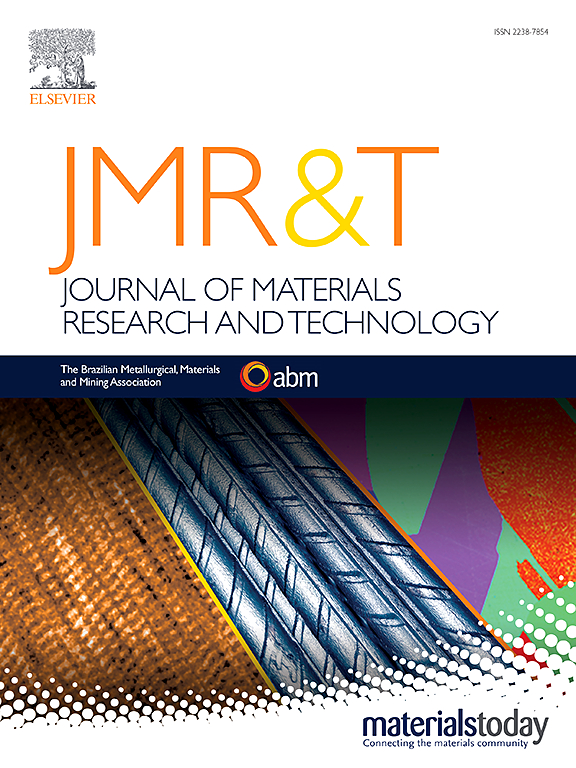硅灰表面改性对胶凝复合材料中聚丙烯纤维-基体相互作用的影响
IF 6.6
2区 材料科学
Q1 MATERIALS SCIENCE, MULTIDISCIPLINARY
Journal of Materials Research and Technology-Jmr&t
Pub Date : 2025-06-09
DOI:10.1016/j.jmrt.2025.06.009
引用次数: 0
摘要
纤维-基体界面是决定纤维增强复合材料力学性能的关键因素。然而,实现最佳界面粘合仍然具有挑战性,特别是对于聚丙烯(PP)等合成纤维,由于其固有的光滑表面和对胶凝基质的低化学亲和力。为了进一步改善PP纤维基质的界面性能,目前的研究评估了三种新型表面处理方法的有效性,使用维多利亚大学开发的硅灰表面涂层方法-粘合剂干涂层,粘合剂湿涂层和非粘合剂热涂层。通过接触角测量、扫描电子显微镜(SEM)、能量色散x射线光谱(EDS/EDX)和显微硬度测试来评估这些表面改性对纤维-基质粘附性的影响。机械性能通过单纤维拉伸、弯曲和抗压强度测试进一步评估。SEM、EDX和显微硬度结果证实,涂层中的硅灰与硅酸盐发生反应,显著改善了距离光纤边缘前40 μm内的界面过渡区(ITZ)。与未经处理的纤维相比,经过干法涂层和湿法涂层处理的样品在拔出试验中的总能量吸收分别高出96%和31%。此外,在弯曲试验中,所有涂层方法的裂纹后能量吸收几乎翻了一番。在表面处理中,使用非粘性热涂层处理的纤维样品表现出最明显的效果,在拉出载荷下,其能量吸收(与未处理的纤维样品相比)提高了857%,导致纤维断裂失效。在这些试样中,破坏机制涉及峰后软化,随后应变硬化到完全塑性响应,直到纤维断裂。基于本研究的力学和微观结构评估,无粘结热涂层方法成为最有效的表面处理方法,具有优异的纤维-基体结合和增强的复合材料性能。本文章由计算机程序翻译,如有差异,请以英文原文为准。
Effects of silica-fume surface modification on polypropylene fiber-matrix interaction in cementitious composites
The fiber-matrix interface plays a pivotal role in determining the mechanical performance of fiber-reinforced composites. However, achieving optimal interfacial bonding remains challenging, particularly for synthetic fibers like polypropylene (PP), due to their inherently smooth surface and low chemical affinity to cementitious matrices. To further improve PP fiber-matrix interface properties, the current study evaluates the effectiveness of three novel surface treatments using silica-fume surface coating methods developed at the University of Victoria—adhesive dry coating, adhesive wet coating, and a non-adhesive heat coating. The impact of these surface modifications on fiber-matrix adhesion was assessed through contact angle measurements, scanning electron microscopy (SEM), energy-dispersive X-ray spectroscopy (EDS/EDX), and micro-hardness testing. Mechanical performance was further evaluated using single-fiber pull-out, flexural, and compressive strength tests. SEM, EDX, and micro-hardness results confirmed that silica-fume from the coatings reacts with portlandite, significantly improving the interfacial transition zone (ITZ) within the first 40 μm from the fiber edge. Samples treated with adhesive dry coating and adhesive wet coating exhibited 96 % and 31 % higher overall energy absorption in pull-out tests, respectively, compared to untreated fibers. Furthermore, all coating methods nearly doubled post-crack energy absorption in flexural tests. Samples containing fibers treated with non-adhesive heat coating demonstrated the most pronounced effect among the surface treatments, resulting in 857 % higher energy absorption (compared to untreated fiber samples) under pull-out loading, leading to fiber fracture failure. In these samples, the failure mechanism involved post-peak softening followed by strain hardening to a perfectly plastic response until fiber fracture. Based on mechanical and microstructural evaluations of the present study, non-adhesive heat coating method emerged as the most effective surface treatment, demonstrating superior fiber-matrix bonding and enhanced composite performance.
求助全文
通过发布文献求助,成功后即可免费获取论文全文。
去求助
来源期刊

Journal of Materials Research and Technology-Jmr&t
Materials Science-Metals and Alloys
CiteScore
8.80
自引率
9.40%
发文量
1877
审稿时长
35 days
期刊介绍:
The Journal of Materials Research and Technology is a publication of ABM - Brazilian Metallurgical, Materials and Mining Association - and publishes four issues per year also with a free version online (www.jmrt.com.br). The journal provides an international medium for the publication of theoretical and experimental studies related to Metallurgy, Materials and Minerals research and technology. Appropriate submissions to the Journal of Materials Research and Technology should include scientific and/or engineering factors which affect processes and products in the Metallurgy, Materials and Mining areas.
 求助内容:
求助内容: 应助结果提醒方式:
应助结果提醒方式:


